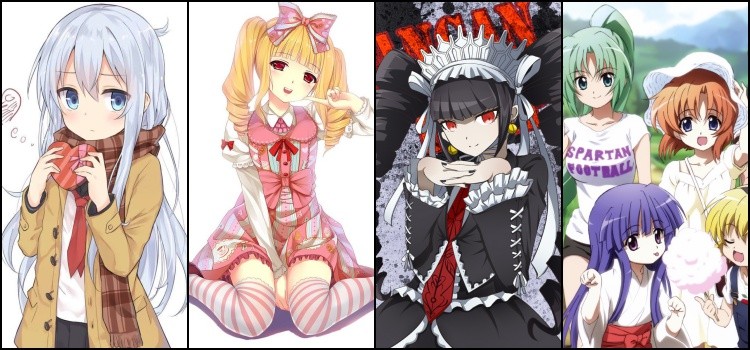Have you ever wondered what lolicon is? What is the difference between lolicon, loli, or lolita? These terms have become quite popular in the West due to anime and manga, but there is a long history and culture behind these words, not to mention that they are words with totally different meanings from each other.
We also recommend reading:
- Moe moe kyun – What is the origin and meaning of moe?
- 13 Types of Japanese Makeup
- Why Japanese Women Don't Shave Pubic Hair?
Table of Content
The difference between loli, lolita and lolicon
These 3 words are totally different from each other. Throughout the article I will quote the 3 words and address issues related to each other, but before I get confused, I want to briefly summarize the meaning of these 3 words.
- Loli – Refers to girls who are younger or who try to look younger;
- Lolita - Currently refers to a Japanese fashion;
- Lolicon – Refers to people who like underage girls or who appear to be underage;
If you want to know more about Lolita, we recommend reading: Lolita Fashion – History, Culture and Types
I'll leave a video below where I talk a little about Lolita, loli and lolicon:
What is a loli and a lolicon?
The word loli especially refers to girls between the ages of 9 and 14, with cute and childish characteristics, often sensual. Basically, lolis are minors, or also adults with childish aspects who act like girls under the age of 14.
There is no age to embrace lolita fashion; it's enough to wear doll-like or childlike clothing. Many tend to associate loli with lolita, but not all loli characters are wearing outfits that are part of lolita fashion.
Some claim that lolis are little girls who are forward and already have an active sex life, a very wrong idea. This is just a generalization created by lolicons and anime. Lolitas usually only stick to clothes and don't even act like children.
Girls who embrace lolita fashion, even if they are of legal age, may end up using the word loli, which is simply an abbreviation of the word lolita. People who adopt this lifestyle also tend to maintain a childlike aspect in psychological terms.
The big problem lies with lolicons. The term "Lolicon" is short for "Lolita complex", a term used in Japan for crimes involving pedophilia and ephebophilia. In other words, basically lolicons are the fanatics and lovers of loli.
This term is also used when a minor in an anime is portrayed in an erotic way or in sensual, or even sexual situations. Lolicons outside of Japan are people who have a crush on girls who appear to be cute kids or schoolgirls.

anime about loli
The anime in question can only present the style of clothing and not that the anime deals with fashion or loli as a focus. It may be that the anime is not even about lolita fashion, it just has loli characters that draw attention.
Rozen Maiden - Due to a deep trauma acquired at school, Jun Sakurada refuses to go back to school, as well as to leave home. Living together with his sister, his hobby is buying cursed items via the internet and returning them before the return deadline is over.
One day he receives an unsolicited package, which contains a beautiful doll that seems to be sleeping. Curious, Jun begins to find out. When to his surprise she proves to be alive, and soon after making him her servant. And now, both will have to face a homicidal opponent to win in Alice's deadly game.
Other anime focused on loli characters:
- Ryo-Kyu-Bu!
- Astarotte no Omocha!
- Kodomo no Jikan
- Renkin San-kyuu Magical? Pokaan
- Strike Witches;
- Mitsudomoe;
- Higurashi no Naku Koro Ni;
- Black Bullet;

top loli characters
Finally, let's leave a list of famous loli characters. It is worth remembering that what defines a character to be a loli is not only her age or childlike appearance but also the clothes she is wearing. Many end up meeting characters but have no idea that the clothes they are wearing are part of the lolita style.
- Suzu Hagimura (Seitokai Yakuindomo);
- Megumin (Konosuba);
- Taiga Aisaka (Toradora);
- Hasegawa Kobato (Boku Wa Tomodachi Ga Sukunai);
- Aihara Enju (Black Bullet);
- Shiro (No Game No Life);
- Nunnally (Code Geass);
- Elizabeth Midford (Kuroshitsuji);
- Irisu Makina (Grisaia no Kajitsu);
- Takanashi Rikka (Chuunibyou Demo Koi ga Shitai!);
- Celestia Ludenberg (Danganronpa);
- Yui (Sword Art Online);
- Chii (Chobits)
- Rinko Ogasawara (shirobako);
- Minene Uryuu (Mirai Nikki);
- Kaolla Su (Love Hina);
- Ruri Goko - Gothic loli (Oreimo);
- Sumiki Miniwa (Acchi Kocchi);
- Remilia Scarlet (Touhou Project);
- Kuroko Shirai (Railgun);
- Rin Kagamine (Vocaloid);
- Konata Izumi (Lucky Star);
- Yui (Sword Art Online);
We also recommend reading:
Gothic Lolita anime characters
It is common in anime, in addition to loli characters, to have some alternative Lolita fashions. The vast majority dress in Gothic Lolita fashion, which includes black or dark clothes, ruffled lace, petticoats and delicate umbrellas. See a list:
- Kuroneko [Oreimo];
- Victorique [Gosick];
- Kurumi Tokisaki [Data a Live]
- Kobato Hasegawa [Kobato Hasegawa]
- Hildagarde [BEelzebub]
- Rory Mercury [Gate]
- Stocking [Panty Stocking]
- Celestia Ludenberg [Danganronpa]
- Perona [One Piece]
- Beatrice [Re:Zero]
- Anna Kushina [K]
- Sunako Kirishiki [Shiki]
- Shalltear Bloodfallen [Overlord]
- Anju Maaka [Karin]
